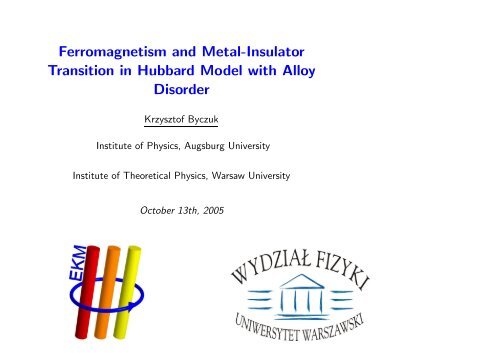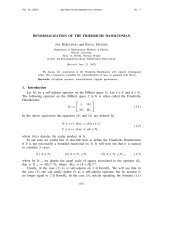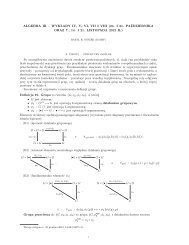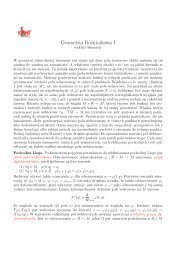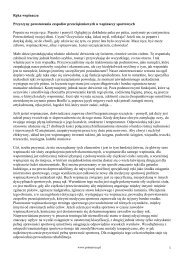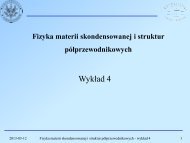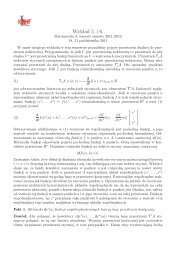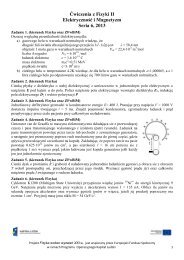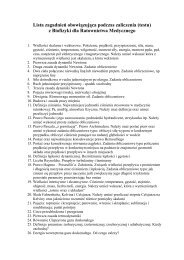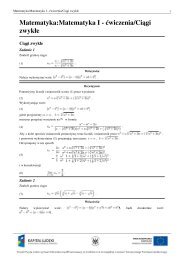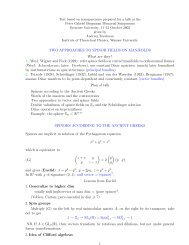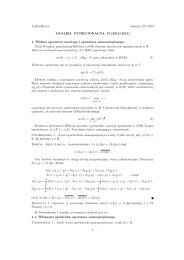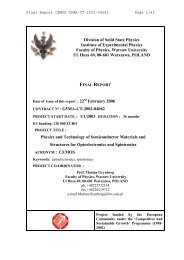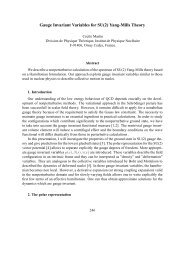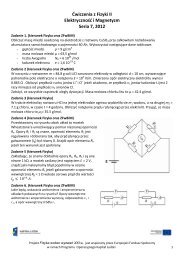Ferromagnetism and Metal-Insulator Transition in Hubbard Model ...
Ferromagnetism and Metal-Insulator Transition in Hubbard Model ...
Ferromagnetism and Metal-Insulator Transition in Hubbard Model ...
Create successful ePaper yourself
Turn your PDF publications into a flip-book with our unique Google optimized e-Paper software.
<strong>Ferromagnetism</strong> <strong>and</strong> <strong>Metal</strong>-<strong>Insulator</strong><br />
<strong>Transition</strong> <strong>in</strong> <strong>Hubbard</strong> <strong>Model</strong> with Alloy<br />
Disorder<br />
Krzysztof Byczuk<br />
Institute of Physics, Augsburg University<br />
Institute of Theoretical Physics, Warsaw University<br />
October 13th, 2005
Ma<strong>in</strong> results<br />
• New collective effects <strong>in</strong>duced by correlation <strong>and</strong> disorder<br />
• Enhancement of Tc <strong>in</strong> b<strong>in</strong>ary alloy ferromagnets<br />
• New Mott–<strong>Hubbard</strong> metal–<strong>in</strong>sulator transition at n = 1<br />
K. Byczuk, M. Ulmke, D. Vollhardt<br />
Phys. Rev. Lett. 90, 196403 (2003)<br />
K. Byczuk, W. Hofstetter, D. Vollhardt<br />
Phys. Rev. B 69, 04512 (2004)<br />
K. Byczuk, M. Ulmke<br />
Eur. Phys. J. B 45, 449 (2005)
Collaboration<br />
• Walter Hofstetter - Aachen, Germany<br />
• Mart<strong>in</strong> Ulmke - FGAN - FKIE, Wachtberg, Germany<br />
• Dieter Vollhardt - Augsburg University, Germany<br />
Plan of the talk<br />
1. Introduction<br />
• localized vs. it<strong>in</strong>erant FM<br />
• Mott-<strong>Hubbard</strong> MIT<br />
• b<strong>in</strong>ary alloy disorder<br />
• alloy FM <strong>in</strong> Nature<br />
2. Earlier result with<strong>in</strong> DMFT on pure FM<br />
3. Our results on b<strong>in</strong>ary alloy FM<br />
• enhancement of Tc<br />
• magnetization <strong>and</strong> Curie–Weiss law<br />
• Mott–<strong>Hubbard</strong> MIT at n = 1<br />
4. Conclusions
<strong>Ferromagnetism</strong> of local moments<br />
Exchange (Heisenberg) coupl<strong>in</strong>g<br />
H = X<br />
Jij Si · Sj<br />
Saturated magnetization M(T = 0) = µBS<br />
ij<br />
T > Tc<br />
T < Tc<br />
J < 0 → FM appears at Curie temperature Tc
It<strong>in</strong>erant <strong>Ferromagnetism</strong><br />
Dynamical way to make FM<br />
To reduce <strong>in</strong>teraction energy electrons prefer FM state<br />
due to Pauli pr<strong>in</strong>ciple E FM<br />
<strong>in</strong>t<br />
However, |E FM<br />
k<strong>in</strong><br />
| < |EPM|<br />
!<br />
k<strong>in</strong><br />
= 0<br />
t
Mott-<strong>Hubbard</strong> MIT at n = 1<br />
U ≪ |tij|, ∆p = 0 U ≫ |tij|, ∆r = 0<br />
typical <strong>in</strong>termediate coupl<strong>in</strong>g problem Uc ≈ |tij|
Alloy B<strong>and</strong> Splitt<strong>in</strong>g<br />
B<strong>in</strong>ary alloy disorder (alloys A1−xBx, e.g Fe1−xCox)<br />
P(ɛi) = xδ(ɛi + ∆<br />
2 ) + (1 − x)δ(ɛi − ∆<br />
2 )<br />
H = P<br />
i ɛi + t P<br />
ij a†<br />
i aj<br />
alloy b<strong>and</strong> splitt<strong>in</strong>g for ∆ W <strong>in</strong> any dimension<br />
<strong>in</strong>termediate “coupl<strong>in</strong>g” problem !!!<br />
physical quantity: O = R dɛP(ɛ) <<br />
E<br />
∆<br />
Ô(ɛ) ><br />
1−x<br />
DOS<br />
x
Alloy Ferromagnets <strong>in</strong> Nature I<br />
Piryts: T1−x(T+1)xS2, T=Fe, Co, Ni, Cu, Zn<br />
t 6<br />
2gen g<br />
with n = 0, 1, 2, 3, 4<br />
Fe1−xCoxS2, max Tc(x) @ x ≈ 0.76<br />
Jarrett et al., PRL 1968, Leighton 2004
Alloy Ferromagnets <strong>in</strong> Nature II<br />
T c (critical temperature: K)<br />
110<br />
109<br />
108<br />
107<br />
106<br />
105<br />
104<br />
103<br />
Theory<br />
Annealed for 14 days at 875 o C<br />
102<br />
0 0.2 0.4 0.6 0.8 1 1.2 1.4 1.6 1.8 2<br />
x (amount of Ge)<br />
MT2X2 ternary <strong>in</strong>termetallic alloys<br />
UCu2Si2−xGex, max Tc(x) @ x ≈ 1.6<br />
Silva Neto et al., PRL 2003<br />
Si <strong>and</strong> Ge isovalent, only structural disorder
Alloy Ferromagnets <strong>in</strong> Nature III<br />
Fe weak FM, Co strong FM, bcc alloy<br />
Fe1−xCox, max Tc(x) @ x ≈ 0.5<br />
Pratzer et al., PRL 2003
Alloy Ferromagnets <strong>in</strong> Nature IV<br />
Alloy ruthenates<br />
SrRu1−xMnxO3, FM Met–AF Ins<br />
Cao et al., cond-mat/0409157
<strong>Hubbard</strong> model to capture right physics<br />
ɛ0 + U<br />
ɛ0<br />
H = X<br />
ɛ0niσ + X<br />
iσ<br />
t<br />
ijσ<br />
• long history, many contradictions<br />
• exactly solvable <strong>in</strong> d = 1<br />
U<br />
• exactly solvable <strong>in</strong> d = ∞ (DMFT)<br />
• how to approximate <strong>in</strong> 1 < d < ∞?<br />
tij a †<br />
iσ ajσ + U X<br />
t<br />
i<br />
E<br />
U=0<br />
E<br />
E F<br />
ni↑ni↓<br />
DOS: ρ(E) = P R<br />
n dx|ψn(x)|δ(E − ɛn)<br />
t=0<br />
U<br />
2(n/2)<br />
ρ( E)<br />
ρ( E)<br />
2(1−n/2)
Physical picture, n = 1<br />
E+U<br />
E<br />
atomic levels<br />
|t|=0 |t|>0<br />
U<br />
UHB<br />
LHB<br />
sp<strong>in</strong> flip on central site<br />
E+U<br />
dynamical processes with sp<strong>in</strong>-flips <strong>in</strong>ject states <strong>in</strong>to correlation gap<br />
giv<strong>in</strong>g a quasiparticle resonance<br />
E<br />
at U = Uc resonance disapears<br />
gaped <strong>in</strong>sulator
Route to FM <strong>in</strong> one-b<strong>and</strong> <strong>Hubbard</strong> (DMFT)<br />
H = P ta †<br />
iσ ajσ + U P ni↑ni↓<br />
1.4<br />
1.2<br />
1<br />
0.8<br />
N<br />
0.6<br />
0 (ε)<br />
0.4<br />
0.2<br />
a=0<br />
a=0.5<br />
a=0.9<br />
a=0.98<br />
a=1<br />
1.4<br />
N 0 (ε)<br />
0.7<br />
0<br />
−2 −1.8<br />
ε<br />
−1.6<br />
0<br />
−2 −1 0<br />
ε<br />
1 2<br />
Wahle et al. 1998<br />
DOS asymmetry - a<br />
0.06<br />
0.05<br />
0.04<br />
0.03<br />
0.02<br />
a=0.97<br />
0.01<br />
a=0.98<br />
a=0.99<br />
a=1 0<br />
Interaction - U<br />
T<br />
T<br />
0.06<br />
0.05<br />
0.04<br />
0.03<br />
0.02<br />
0.01<br />
F<br />
a=1<br />
a=0.98<br />
a=0.97<br />
0 0.2 0.4 0.6 0.8 1<br />
n<br />
F<br />
U=8<br />
U=6<br />
U=4<br />
0<br />
0 0.2 0.4 0.6 0.8 1<br />
n<br />
P<br />
P<br />
U = 4<br />
a = 0.98
FCC d =∞ FM <strong>in</strong> one-b<strong>and</strong> <strong>Hubbard</strong><br />
M<br />
0.6<br />
0.4<br />
0.2<br />
√ π(1+ √ 2ɛ)<br />
N 0 (ɛ) = exp[−1+√ 2ɛ<br />
2<br />
U=4<br />
n=0.58<br />
0<br />
0.03 0.05 0.07<br />
T<br />
0.09<br />
Ulmke et al. 1998<br />
]<br />
4<br />
χ −1<br />
F<br />
T<br />
N(ω)<br />
0.06<br />
0.04<br />
0.02<br />
0<br />
1.2<br />
0.8<br />
0.4<br />
P<br />
F<br />
0 0.2 0.4 0.6 0.8 1.0<br />
n<br />
U=4<br />
n=0.58<br />
T=0.04<br />
M=0.4<br />
0<br />
−2.0 0.0 2.0<br />
ω−µ<br />
4.0 6.0<br />
U = 2, 4, 5
FM <strong>in</strong> b<strong>in</strong>ary alloy it<strong>in</strong>erant electrons<br />
Anderson–<strong>Hubbard</strong> Hamiltonian<br />
H = X<br />
ij,σ<br />
tijĉ †<br />
iσ ĉjσ + X<br />
iσ<br />
ɛiˆniσ + U X<br />
i<br />
ˆni↑ˆni↓<br />
where ɛ is r<strong>and</strong>om variable with bimodal PDF<br />
„<br />
P(ɛ) = xδ ɛ + ∆<br />
«<br />
„<br />
+ (1 − x)δ ɛ −<br />
2<br />
∆<br />
«<br />
2<br />
Physical observable averaged arithmetically<br />
Z<br />
〈· · · 〉dis = dɛP(ɛ)(· · · )<br />
d = ∞ FCC DOS stabilizes FM<br />
N 0 (ω) = exp[−1+√ 2ω<br />
2 ]<br />
q<br />
π(1 + √ 2ω)
Dynamical Mean–Field Theory<br />
Local Green function - Hilbert transform of DOS with self–energy<br />
Gσn =<br />
Z<br />
N<br />
dɛ<br />
0 (ɛ)<br />
iωn + µ − Σσn − ɛ<br />
expressed by path <strong>in</strong>tegral, which is calculated with<br />
<strong>Hubbard</strong>–Stratonovich <strong>and</strong> QMC over auxiliary Is<strong>in</strong>g sp<strong>in</strong>s<br />
Gσn = −<br />
*R D [cσ, c ⋆<br />
⋆<br />
σ ] cσncσneAi {cσ,c ⋆ σ ,G−1 σ }<br />
R D [cσ, c ⋆ σ ] eA i {cσ,c ⋆ σ ,G−1<br />
σ }<br />
s<strong>in</strong>gle impurity action for each ɛi = ±∆/2<br />
Ai{cσ, c ⋆<br />
σ<br />
X<br />
, G−1<br />
σ } = c<br />
n,σ<br />
⋆<br />
σnG−1 σncσn−ɛi X<br />
σ<br />
k–<strong>in</strong>tegrated Dyson equation for Weiss function<br />
G −1<br />
σn<br />
= G−1<br />
σn<br />
+ Σσn<br />
Zβ<br />
0<br />
+<br />
dis<br />
dτnσ(τ)− U<br />
2<br />
X<br />
σ<br />
Zβ<br />
0<br />
dτc ∗<br />
∗<br />
σ (τ)cσ(τ)c −σ (τ)c−σ(τ)
T c<br />
T c<br />
T c<br />
T c<br />
Curie temperature<br />
0.04<br />
0.03<br />
0.02<br />
0.01<br />
0<br />
0.05<br />
0.04<br />
0.03<br />
0.02<br />
0.01<br />
0<br />
0.03<br />
0.02<br />
0.01<br />
0<br />
0.08<br />
0.06<br />
0.04<br />
0.02<br />
0<br />
∆=1<br />
∆=4<br />
Mott<br />
n=0.3<br />
U=2<br />
U=6<br />
0 0.1 0.2 0.3 0.4 0.5 0.6 0.7 0.8 0.9 1<br />
concentration, x<br />
n=0.7<br />
U=2<br />
U=6<br />
∆=1<br />
∆=4<br />
0 0.1 0.2 0.3 0.4 0.5 0.6 0.7 0.8 0.9 1<br />
concentration, x<br />
Mott<br />
T c<br />
T c<br />
0.06<br />
0.04<br />
0.02<br />
0<br />
0 1 2 3 4<br />
0.038<br />
0.028<br />
0.018<br />
0.008<br />
(b)<br />
Tc(x) <strong>in</strong>creases !!! at some cases<br />
T c<br />
0.07<br />
0.06<br />
0.05<br />
0.04<br />
0.03<br />
0.02<br />
0.01<br />
0<br />
U=2<br />
(a)<br />
U=4<br />
n>x<br />
U=6<br />
n
E<br />
∆<br />
Is there an alloy b<strong>and</strong> splitt<strong>in</strong>g at U > 0?<br />
1−x<br />
DOS<br />
x<br />
U = 4, n = 0.3, n = 0.5, T = 0.071, MEM<br />
SPECTRAL DENSITY<br />
LHB<br />
∆=0.0<br />
UHB<br />
∆=0.4<br />
∆=1.0<br />
∆=1.4<br />
∆=1.8<br />
−1 0 1 2 3 4 5<br />
ω−µ<br />
Subtle <strong>in</strong>terplay between ∆ <strong>and</strong> U <strong>in</strong>creases Tc!
E<br />
∆<br />
Why is Curie temperature enhanced?<br />
1−x<br />
DOS<br />
x<br />
n < 2x → neff = n<br />
x<br />
Tc = xT p<br />
c<br />
T c<br />
T<br />
p<br />
c<br />
(n)<br />
Tc(x) <strong>in</strong>creases !!! at some cases<br />
n > 2x → neff = n−2x<br />
1−x<br />
Tc = (1 − x)T p<br />
c<br />
T c<br />
T<br />
p<br />
(<br />
c n eff )<br />
(n)<br />
Tc<br />
x<br />
n n eff<br />
U1<br />
U<br />
0.0 0.5 1.0<br />
T c (n)<br />
n<br />
eff<br />
1−x<br />
Tc p (neff )<br />
U 1<br />
Tc p (n)<br />
2<br />
U 2<br />
0.0 0.5 1.0<br />
n<br />
T<br />
0.06<br />
0.04<br />
0.02<br />
n<br />
n<br />
P<br />
0<br />
0 0.2 0.4 0.6 0.8 1.0<br />
n<br />
F<br />
Good for large U<br />
Good for small U
T c<br />
T c<br />
T c<br />
T c<br />
Magnetization <strong>and</strong> Curie-Weiss law<br />
0.04<br />
0.03<br />
0.02<br />
0.01<br />
0<br />
0.05<br />
0.04<br />
0.03<br />
0.02<br />
0.01<br />
0<br />
0.03<br />
0.02<br />
0.01<br />
0<br />
0.08<br />
0.06<br />
0.04<br />
0.02<br />
0<br />
∆=1<br />
∆=4<br />
Mott<br />
n=0.3<br />
U=2<br />
U=6<br />
0 0.1 0.2 0.3 0.4 0.5 0.6 0.7 0.8 0.9 1<br />
concentration, x<br />
n=0.7<br />
U=2<br />
U=6<br />
∆=1<br />
∆=4<br />
0 0.1 0.2 0.3 0.4 0.5 0.6 0.7 0.8 0.9 1<br />
concentration, x<br />
Mott<br />
M(T) , χ −1 (T)<br />
0.6<br />
0.5<br />
0.4<br />
0.3<br />
0.2<br />
0.1<br />
0<br />
x=0.6, U=6, n=0.3<br />
x=0.1, U=2, n=0.7<br />
If ∆ ≫ W <strong>and</strong> n < 2x → Ms = n but n > 2x → Ms = n − 2x<br />
∆=4<br />
0 0.02 0.04 0.06 0.08 0.1 0.12 0.14 0.16 0.18 0.2<br />
kT<br />
M(T)<br />
Ms<br />
= tanh[TcM(T)<br />
TMs ]<br />
χ(T) = C<br />
T −Tc<br />
, where C ≈ Ms<br />
C1 C = 0.623 close to<br />
2 3<br />
5
T c<br />
T c<br />
T c<br />
T c<br />
Mott–<strong>Hubbard</strong> metal–<strong>in</strong>sulator transition<br />
0.04<br />
0.03<br />
0.02<br />
0.01<br />
0<br />
0.05<br />
0.04<br />
0.03<br />
0.02<br />
0.01<br />
0<br />
0.03<br />
0.02<br />
0.01<br />
0<br />
0.08<br />
0.06<br />
0.04<br />
0.02<br />
0<br />
∆=1<br />
∆=4<br />
Mott<br />
n=0.3<br />
U=2<br />
U=6<br />
0 0.1 0.2 0.3 0.4 0.5 0.6 0.7 0.8 0.9 1<br />
concentration, x<br />
n=0.7<br />
U=2<br />
U=6<br />
∆=1<br />
∆=4<br />
0 0.1 0.2 0.3 0.4 0.5 0.6 0.7 0.8 0.9 1<br />
concentration, x<br />
Mott<br />
A( ω)<br />
µ<br />
LHB<br />
µ<br />
2N L<br />
ω<br />
xNL<br />
µ µ<br />
U<br />
METAL<br />
U<br />
µ<br />
LAB UAB<br />
2xNL<br />
2(1−x)NL<br />
µ<br />
xNL<br />
∆<br />
INSULATOR<br />
If n = x (or 1 + x) Mott-<strong>Hubbard</strong> MIT occures for ∆ > √ x <strong>and</strong> U > 6 √ x (or √ 1 − x <strong>and</strong> 6 √ 1 − x)<br />
SPECTRAL DENSITY<br />
UHB<br />
∆ c<br />
U = 6, x = 0.5, n = 0.5, T = 0.071, MEM<br />
0.8<br />
0.6<br />
0.4<br />
0.2<br />
TEMPERATURE T<br />
0.08<br />
0.06<br />
0.04<br />
0.02<br />
0<br />
PM<br />
FM<br />
0 1 2<br />
DISORDER ∆<br />
∆<br />
U c<br />
0<br />
−2 −1 0 1 2<br />
ω−µ<br />
3 4 5 6 7<br />
PI
Correlated <strong>in</strong>sulators<br />
• alloy Mott <strong>in</strong>sulator<br />
• alloy charge transfer <strong>in</strong>sulator<br />
ε+<br />
∆<br />
ε+<br />
U<br />
U< ∆ U> ∆<br />
UHB<br />
ε + U<br />
ε + ∆<br />
UHB<br />
UAB UAB<br />
ε LHB ε LHB<br />
alloy Mott<br />
<strong>in</strong>sulator<br />
alloy charge transfer<br />
<strong>in</strong>sulator
T c<br />
T c<br />
Quantum critical po<strong>in</strong>ts<br />
0.04<br />
0.03<br />
0.02<br />
0.01<br />
0<br />
0.05<br />
0.04<br />
0.03<br />
0.02<br />
0.01<br />
0<br />
∆=1<br />
∆=4<br />
Mott<br />
n=0.3<br />
U=2<br />
U=6<br />
0 0.1 0.2 0.3 0.4 0.5 0.6 0.7 0.8 0.9 1<br />
concentration, x<br />
T c<br />
T c<br />
0.03<br />
0.02<br />
0.01<br />
0<br />
0.08<br />
0.06<br />
0.04<br />
0.02<br />
0<br />
n=0.7<br />
U=2<br />
U=6<br />
∆=1<br />
∆=4<br />
0 0.1 0.2 0.3 0.4 0.5 0.6 0.7 0.8 0.9 1<br />
concentration, x<br />
At T = 0 quantum phase transitions: FM met → PM <strong>in</strong>s or FM met → PM <strong>in</strong>s (Mott).<br />
Correlation (b<strong>and</strong>-width) controlled, Fill<strong>in</strong>g controlled, Alloy concentration controlled Mott MITs.<br />
Is non-Fermi liquid <strong>in</strong> d < ∞ ? Role of correlations <strong>in</strong> space.<br />
Mott
Summary<br />
• New collective effects <strong>in</strong>duced by correlation <strong>and</strong> disorder<br />
• Possibilities of Tc <strong>in</strong>crease <strong>in</strong> b<strong>in</strong>ary alloy ferromagnet<br />
• New Mott–<strong>Hubbard</strong> metal–<strong>in</strong>sulator transition at n = 1<br />
• Alloy Mott <strong>in</strong>sulator vs. Alloy charge transfer <strong>in</strong>sulator<br />
• Alloy concentration controlled Mott MIT<br />
Outlook<br />
• Tc(x) - QPT ? 2nd vs 1st order PT ?<br />
• Multi-b<strong>and</strong> <strong>Hubbard</strong> model, role of Hund <strong>and</strong> exchange coupl<strong>in</strong>g,<br />
which from our f<strong>in</strong>d<strong>in</strong>gs are generic for many orbitals ?<br />
• Material specific models ?? LDA+DMFT+disorder ???


